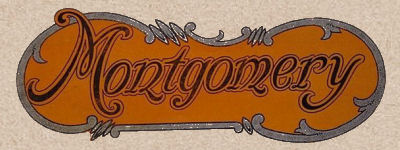


A NEW SIDECARRIAGE
LAST week we had the pleasure of a short ride in a new form of sidecarriage, the invention of Mr. Montgomery, of Bury St. Edmunds.
The particular point about this side car, which is novel, is the method of attaching it to the bicycle frame. In place of rigid lugs connected by tubes to the front part of the side car and the axle, we have here a kind of toggle joint, which allows the sidecar to rise and fall independently of the bicycle, and also allows the bicycle to run in a vertical position, no matter what the angle of the road may be. It is particularly adaptable to turning corners at any speed, as the bicycle can assume the ordinary angle which every single-track machine makes when rounding a curve; while doing this there is no tendency to lift the side car, and it can be driven empty round a sharp corner at high speed without any chance of it upsetting. Owing to the flexible joint and the fact that the bicycle requires to be balanced in the same manner as when running singly, it is a little strange to those who have been accustomed to the fixed form. This strangeness, however, is soon overcome, and it is then that the delightful freedom of the side car is appreciated.
The Motor Cycle, September 9th 1903.
The Montgomery.
Motor cyclists who are contemplating the attachment of an additional seat to their present motor bicycles cannot do better than visit Stand No. 1, where the Montgomery sidecarriage is shown in its latest form. In the early part of the autumn we gave a fully-illustrated and detailed description of this. An important feature in the construction of the Montgomery sidecarriage is the method of its attachment to the bicycle. A bracket is clipped to the back stay of the bicycle and remains as a fixture. The duplex axle of the sidecar carries at its inner extremity two links which connect up to two studs of ample dimensions, which in their turn are fixed to the bracket before mentioned attached to the back fork. The front attachment is formed by a clip embracing the down tube. This carries a similar link arrangement which connects to the transverse tube, forming the front of the frame of the forecarriage. The result of this method of fixing is that a great saving is effected in the wearing of the sidecar tyre, owing to its being able to ride easily over any inequalities of the road, thus contributing to the comfort of the passenger. The sidecarriage, which is extremely light in construction, is shown in many attractive forms and attached to a variety of makes of bicycles. (Stand 1)
The Motor Cycle November 25th, 1903. p852
Crystal Palace Show 1903 Index
If you have further information or a query related to this page, please contact us